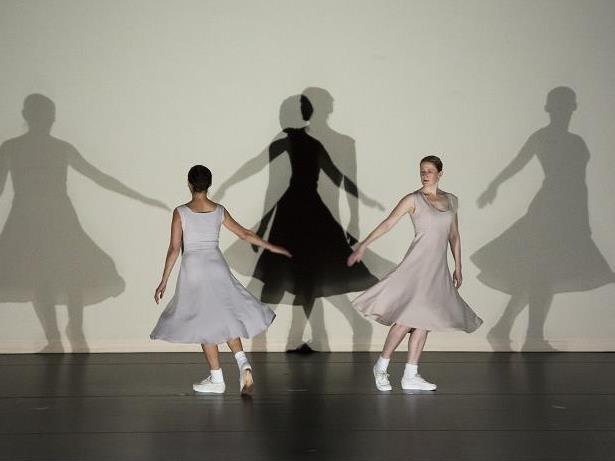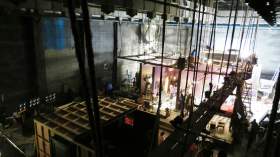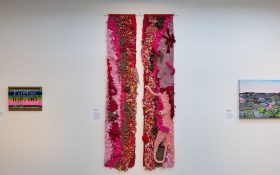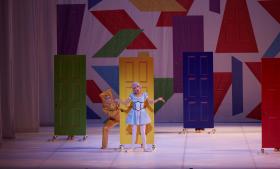Photo by Jamie Williams.
One of the headline major productions of this year’s Sydney Festival, Fase, Four Movements to the music of Steve Reich, is powerful, hypnotic and for serious contemporary dance fans. Anne Teresa de Keersmaeker and her company Rosas are from Belgium. The choreography is based on a prolific and rigorous exploration of the relationship between dance and music and draws on formal geometric principles, numerical patterns, the natural world and social structures.
In this particular work there are two performers, De Keersmaeker herself and Tale Dolven.
First performed in 1982 and considered a seminal work of contemporary dance, in some ways the austere, minimalist work is perhaps similar to the work of Merce Cunningham in collaboration with John Cage, in the use of numbers, repetition and analysis of space. The two performers are coolly neutral and expressionless throughout. Abstract, seemingly almost robotic movements are performed so skillfully that they appear almost fascinatingly mechanical and yet strangely affecting.
The work is divided into four parts – piano, come out, violin, and clapping dance.
The first, Piano Phase, features Reich’s relentless, pounding piano music with the two dancers appearing in white sleeveless dresses with white socks and sneakers. Dramatic use is made of shadows against the white screen backdrop as the work explores space, rhythm and repetition with dizzying turns and arms held at shoulder height. At times the dancers are in alignment, at others they turn counter to each other.
Come Out, the second movement, sees the dancers in grey military style slacks and tops, with black boots, lit by two overhead lamps as if being harshly interrogated. The sound track is a disturbing electronic score that was created by cutting and splicing recording tape, disjointing a sentence spoken by a young man accused of helping incite the Harlem riot of 1964. At times the music is like the screech of a plane. This segment has more angular elbows and arms behind the head movements, that lead to arm swings and forwards bends. Sometimes they sit facing the same way, sometimes they turn away from each other as they repeat phrases of movement and turn in a circle seated on the stool.
The third movement, Violin Phase, was a solo for De Keersmaeker in the white dress again but with strappy sandals and socks not sneakers. In some ways I thought of Stravinsky’s collaboration with Balanchine. It opened very softly, with De Keersmaeker barely visible in the darkness as the lights are gradually raised. It was intense yet perhaps childlike and freer in movement yet still very controlled – there were sort of skipping movements, a swivel-hop, a knee flick and a sort of grande battement at times as she moved around the circle of light. There was also a repeated touch of the floor movement and some soft jumps . Arms, especially at first, were held quite low.
The Clapping Dance as the final movement was perhaps influenced by Twyla Tharp. The two dancers were back in their military style outfits for Come Out but with white sneakers. The clapping on recorded soundtrack was fast and staccato, a cross between Flamenco and almost sounding like gunshots. It started dramatically with an oblong of light against the back white screen and then the dancers eventually moved to where the overhead hanging lamps had been located. Again, the two were sometimes in alignment, sometimes working in counterpoint to each other, with lunges and a diagonal body line at times, arms extended and there were rises virtually en pointe in the sneakers.
Fase reveals the influence of Lucinda Childs’ work in Einstein on the Beach, and also serves as a kind of farewell. Minimalism’s other original leaders already had choreographers who helped make their music accessible — Childs for Philip Glass, Anna Halpern for Terry Riley, for example.
Overall, delicacy and chaos are combined with simplicity and complexity.
Rating: 3.5 stars out of 5
Fase, Four Movements to the music of Steve Reich
Choreography by Anne Teresa de Keersmaeker
Danced by Anne Teresa de Keersmaeker and Tale Dolven
Music by Steve Reich
Drama Theatre Sydney Opera House
9-11 January 2016
Running time – 70 minutes no interval
Sydney Festival





